Moritz Mieg, 22, lay face down in the rubble, the ground shaking violently beneath him. Boulders crashed down around him, some stones hitting his back.
“I just hoped that it would be one big hit and over, because I did not want to be hit nearly to death and then have to slowly die,” the student from Germany tells Taipei Times.
MORNING WALK
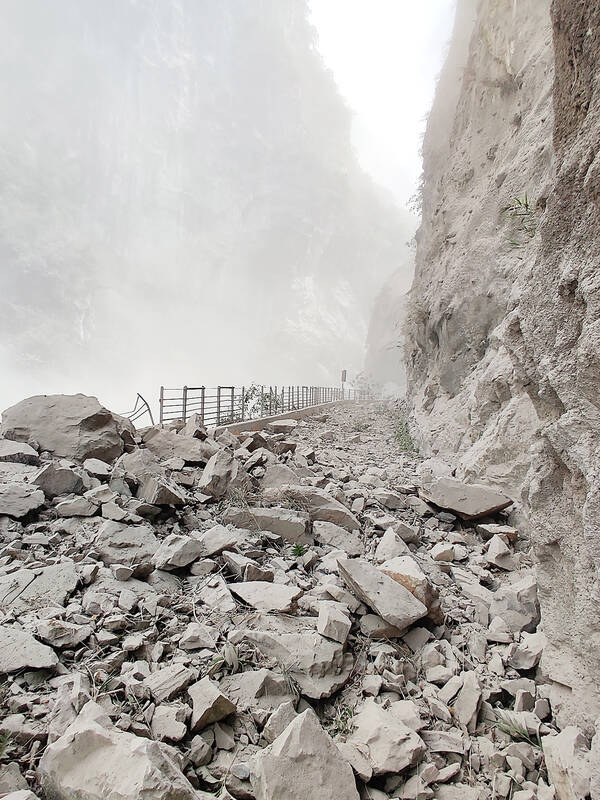
Photo courtesy: Moritz Mieg
Early on April 3, Mieg set out on a scenic hike through Taroko Gorge in Hualien County (花蓮). It was a fine day for it. Little did he know that the complex intersection of tectonic plates Taiwan sits upon were jarring.
Mieg had initially planned to hike the Shakadang Trail (砂卡噹步道). But at the last minute, the hostel owner suggested he start at Baiyang Trail (白楊步道) instead.
He parked his scooter at a small store near Jinheng Park (靳珩公園) and snapped a picture, timestamped at 7:55am. He then began hiking. But just minutes later, at 7:58am, the earthquake struck 50km northeast of where he was walking. The 7.2 magnitude quake was Taiwan’s strongest in 25 years. Taroko’s Shakadang Trail was hit particularly hard: five hikers lost their lives and two remain missing at the time of writing. The death toll currently stands at 17 and rescue missions are ongoing due to landslides and aftershocks.
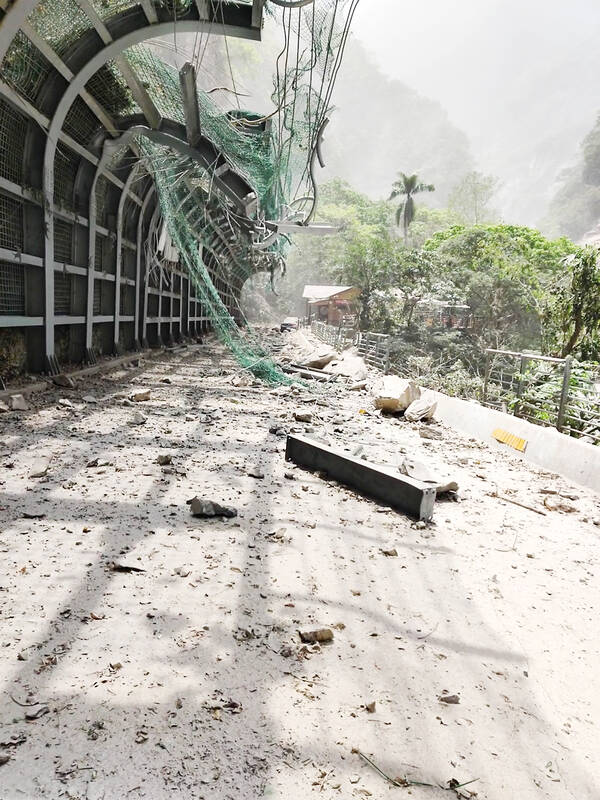
Photo courtesy: Moritz Mieg
An exchange student studying at National Taiwan Normal University, Mieg had arrived in Taipei just two months before. Growing up in Europe, he’d never experienced anything like an earthquake, and found himself utterly unprepared.
Recalling his initial confusion, he remembers the alert vibrated his phone.
Immediately after, “I felt the earthquake and rocks falling down. Those two things happened at the same time in my memory. . . while running, I realized, yeah that’s why my phone was going crazy a second ago,” he says.
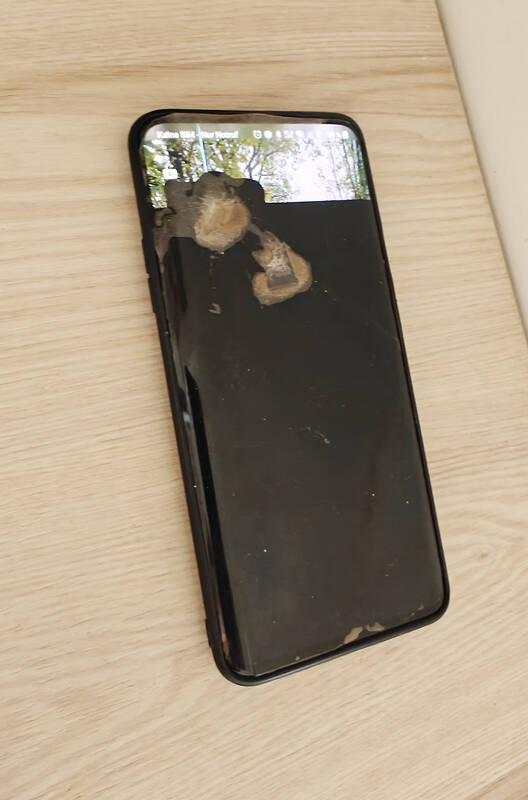
Photo courtesy: Moritz Mieg
A barrage of boulders and debris rained down on him. One sharp blow to his head left an open wound. He sustained multiple cuts and bruises on both legs and his face, bleeding from beneath his eyebrow, teeth and gums on one side.
Mieg sprinted for cover and threw himself flat along the side of a cliff face.
“I kind of hid my head under my arms and waited for it, the quake or my life, to be over.”
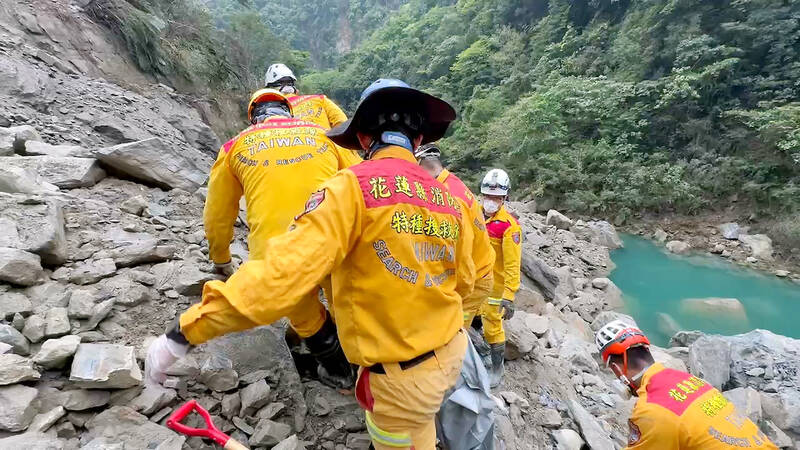
Photo by Hsu Sheng-lun, Taipei Times
Soon everything turned black.
“My first thoughts were that I am either buried under rocks or I’ve turned blind by the hit on my head.”
He then realized the rock fall had caused plumes of dust, blocking out the sunlight.
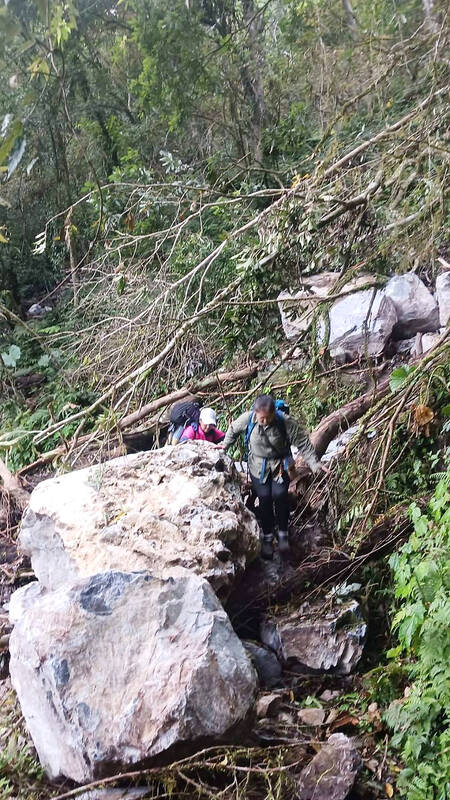
Photo courtesy: Chairman of Taroko Tongli Tribal Natural Ecology Autonomous Association
Mieg would wait for four and a half long hours, hiding from aftershocks in the darkness and screaming for help. On his smashed phone, only a small strip of screen remained visible, displaying the time. His SOS call failed in the signal blackout and he neither heard, nor saw any sign of other survivors on the devastated trail.Wrapping his head in a t-shirt to stem the bleeding, he feared the worst, put on a red jacket to aid rescuers in finding him.
FINDING A WAY OUT
Once the aftershocks dissipated and the dust had settled, Mieg knew he had to take his chances and try to find help. Motivated by his fear of being “back in the darkness” once the sun set, he began limping back towards the store where he’d parked his bike, not knowing if anyone there had survived, or the extent of his own injuries. To his relief, the store remained standing. Four workers and six tourists were taking refuge inside. One Swiss national had also sustained a severe head injury, was vomiting from a concussion and ultimately needed stitches.
The search and rescue team arrived at 11:30pm, and immediately escorted the group to hospital. Mieg did not return to his accommodation until 3am, almost 20 hours after he had left on that fateful morning walk.
His three travel companions at his Taroko hostel, as well as friends in Taipei, had been in communication with his desperately worried girlfriend and parents back home in Germany. Everyone was overwhelmed with relief when he finally made contact.
Today, weeks after the main earthquake, Mieg is still injured and struggles to walk on his right leg.
“Apart from that I feel surprisingly well,” he says.
He regularly calls home for emotional support, as the hundreds of aftershocks that have followed the original quake leave him anxious. However, he knows he had an incredibly lucky escape thanks, in part, to some quick thinking and gut instinct.
TRAVEL ADVICE
■ Currently both the Shakadang Trail and Baiyang Trail are temporarily closed due to earthquake damage. When they reopen, hikers should exercise extreme caution before considering a visit due to ongoing aftershocks and landslides.
■ If you should experience an earthquake in a rocky or mountainous areas, find a tunnel or some form of shelter to avoid falling rocks.
■ Water, snacks, a first aid kit and a flashlight are essential for all long hikes in earthquake prone Taiwan.
■ Inform friends and loved ones of your route before you depart and don’t go alone.
■ Check local information and official advice before setting out.

Taiwanese chip-making giant Taiwan Semiconductor Manufacturing Co (TSMC) plans to invest a whopping US$100 billion in the US, after US President Donald Trump threatened to slap tariffs on overseas-made chips. TSMC is the world’s biggest maker of the critical technology that has become the lifeblood of the global economy. This week’s announcement takes the total amount TSMC has pledged to invest in the US to US$165 billion, which the company says is the “largest single foreign direct investment in US history.” It follows Trump’s accusations that Taiwan stole the US chip industry and his threats to impose tariffs of up to 100 percent

On a hillside overlooking Taichung are the remains of a village that never was. Half-formed houses abandoned by investors are slowly succumbing to the elements. Empty, save for the occasional explorer. Taiwan is full of these places. Factories, malls, hospitals, amusement parks, breweries, housing — all facing an unplanned but inevitable obsolescence. Urbex, short for urban exploration, is the practice of exploring and often photographing abandoned and derelict buildings. Many urban explorers choose not to disclose the locations of the sites, as a way of preserving the structures and preventing vandalism or looting. For artist and professor at NTNU and Taipei

March 10 to March 16 Although it failed to become popular, March of the Black Cats (烏貓進行曲) was the first Taiwanese record to have “pop song” printed on the label. Released in March 1929 under Eagle Records, a subsidiary of the Japanese-owned Columbia Records, the Hoklo (commonly known as Taiwanese) lyrics followed the traditional seven characters per verse of Taiwanese opera, but the instrumentation was Western, performed by Eagle’s in-house orchestra. The singer was entertainer Chiu-chan (秋蟾). In fact, a cover of a Xiamen folk song by Chiu-chan released around the same time, Plum Widow Missing Her Husband (雪梅思君), enjoyed more

From insomniacs to party-goers, doting couples, tired paramedics and Johannesburg’s golden youth, The Pantry, a petrol station doubling as a gourmet deli, has become unmissable on the nightlife scene of South Africa’s biggest city. Open 24 hours a day, the establishment which opened three years ago is a haven for revelers looking for a midnight snack to sober up after the bars and nightclubs close at 2am or 5am. “Believe me, we see it all here,” sighs a cashier. Before the curtains open on Johannesburg’s infamous party scene, the evening gets off to a gentle start. On a Friday at around 6pm,